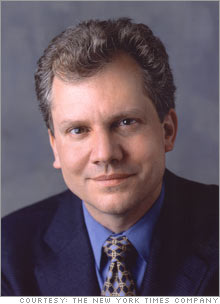Sulzberger's revengeThe New York Times dynasty is pulling hundreds of millions of dollars out of Morgan Stanley in response to a fund manager's move, Tim Arango reports in a Fortune exclusive.NEW YORK (Fortune) -- Arthur Sulzberger Jr. survived the Jayson Blair scandal and Judith Miller's jailing, but as proxy season beckons, the publisher and chairman of The New York Times faces a new challenge. This one is from Hassan Elmasry, a London- based managing director of Morgan Stanley Investment Management who has been trying to incite a shareholder revolt against Sulzberger. Unfortunately for Morgan Stanley CEO John Mack, Elmasry's campaign is turning into a high-priced headache.
Fortune has learned from a New York Times source and others close to the matter that the Ochs-Sulzberger family recently put in a request to pull the majority of its assets from the bank. (Morgan Stanley (Charts) had been the longtime custodian of the family's assets, including its stake in the Times company - which, based on recent share prices, is worth close to $640 million.) Elmasry is in charge of Morgan Stanley's American and Global Franchise Strategies Portfolio, an $11.5 billion investment fund that owns about 7.6 percent of the Times' nonvoting shares. The stock, now around $24, is down nearly 40 percent over the past two years. His response: a proposal that the company eliminate its dual shareholder structure, which he believes fails to provide adequate oversight of management. Like News Corp. (Charts) and Viacom (Charts), the New York Times Co. (Charts) has both class A and class B shares. The A shares trade on the open market; the Times B shares are solely owned by Ochs-Sulzberger family members. They control the board through ownership of these B shares, which represent less than 1 percent of the shares outstanding and let them elect nine of the 13 board members. Including A shares, the family owns a combined equity interest of 19 percent. Elmasry's campaign went nowhere last fall: The Securities and Exchange Commission ruled in December that the company was not required to put Morgan Stanley's proposal to a shareholder vote. "The Times company does not want to open its doors to the kind of turmoil that really rips apart an organization," says Janet Robinson, CEO of the New York Times Co., referring to recent shareholder uprisings at Knight Ridder and Tribune Co. (Charts) "This is a very important institution not only to the media community but to the nation at large." (Recently Robinson announced an $814 million writedown on the Boston Globe and another New England paper - an accounting charge that highlighted a past financial misstep.) A source close to Mack said that he would have preferred that Elmasry had never gone after the paper of record. But this person emphasized that the Morgan Stanley CEO, who works on the opposite end of Times Square from Sulzberger, has never sought to interfere. Such meddling would conflict with Elmasry's obligation to his investors. (Representatives for Elmasry and Morgan Stanley declined to comment.) Elmasry's cause will be strengthened if he succeeds in lining up Bruce Sherman, the head of Boca Raton-based Private Capital Management. He is the largest owner of Times stock outside the family, with an 18.5 percent stake. Sherman also, of course, was the activist shareholder who forced the sale of newspaper chain Knight Ridder to McClatchy (Charts). He has had discussions with Elmasry but has not yet decided if he wants to jump into the fray. Any result from a campaign by Elmasry and Sherman to withhold votes for Times directors would be largely symbolic - but the attendant publicity could put Sulzberger's management skills under additional scrutiny. For his part, Sulzberger has tried to keep the Morgan Stanley gadfly at arm's length. Elmasry first raised his gripes in a June 2005 letter, but it wasn't until nine months later, in March 2006, that he got a sit-down with Sulzberger. |
|

